Live
- Scientists develop flexible near-infrared devices for wearable sensors
- Transforming education for the workforce of tomorrow
- Despite global odds, GDP growth at 6-7% good for India
- IIFL Home Fin to raise Rs 500 cr
- Sensex, Nifty drift lower on profit booking
- Jagan treated cadres as ‘subordinates’, alleges Grandhi
- Mpower’s survey on edu loans
- IIP growth falls to 3.5% in Oct
- Easing food prices lower retail inflation to 5.48% in November
- Space allocation for packaging units at MSME parks on anvil
Just In
Direct cash support for poor key to spur growth


Direct cash support for poor key to spur growth
GDP recovery likely in 2021; Stimulus steps for MSMEs fail to meet expectations
As the New Year dawns, the entire world looks back on the past as a year of fear and dread. The Covid pandemic has not only impacted the health of millions of ordinary people but also their economic wellbeing. Right from the smallest of emerging economies to mighty superpowers, the pervasive virus has led to lockdowns and restrictions that have affected all types of industrial and service establishments.
Those employed in these institutions have faced immense hardships as many have downed shutters, others have retrenched workers and yet others have cut wages. Most countries have tried to help those who have been badly affected, some in the form of a fiscal stimulus and some by way of direct cash transfers. These measures recognise that financial hardship needs to be ameliorated even if it means that fiscal prudence is thrown by the wayside.
India has been distinguished by having declared one of the smallest fiscal stimulus packages in the world despite the massive amount of dislocation and deprivation caused by the initial lockdown in March and the subsequent curbs on movement. Economic growth fell by a record 24 per cent in the first quarter of the current fiscal (April to June 2020-21).
Yet most of the stimulus measures announced by the government were in the form of easier credit availability from banks, rather than direct support from the exchequer. Others were medium- and long-term investment plans for infrastructure development. Credit packages were unveiled for the worst-affected small and medium enterprises, but failed to meet the needs of many in this segment. A series of reforms for the farm sector were also announced, but these led to the ongoing farmers' agitation for repealing the new laws.
Simultaneously unemployment data showed more people were out of work than ever before. In other words, it looked like many of the measures announced by the government in phases from May onwards were not going to end up reviving growth. Surprisingly, however, the economic recovery has been far better than expected over the past few months with international rating agencies now revising their growth estimates upwards for the current fiscal.
As against a net decline of over 11.5 per cent expected earlier for 2020-21, Moody's has now pegged negative growth at 10.6 per cent.
One of the unique aspects of the slowdown during the pandemic has been the contrary behaviour, in a sense, of the stock markets. After a complete collapse in March and April, the Bombay Stock Exchange began to move upwards and even though other economic indicators continued to be on the downswing, the bulls took control. In this respect, the Indian markets reflected the buoyancy of those in other countries, which also showed similar trends.
One of the reasons for this unexpected bullishness at a time of economic downturn has been the entry of a whole new generation of young investors in the stock markets. With returns from other asset classes like bank fixed deposits or real estate showing dismal returns, many investors transferred funds to the equity markets. The net result has been that the Sensex has ultimately not only gone back to pre-Covid levels but crossed the January peak of 42,274 to finally end the year at a record high of 47,751.
As for the recovery in the second quarter (July to September), the negative growth was 7.5 per cent, much lower than in the first disastrous three months. Subsequently also other indicators have been more positive than earlier expected including higher inflows of the Goods and Services Tax (GST), petroleum consumption returning to nearly pre-Covid levels, railway freight rising, and demand for automobiles and FMCG goods showing a sustained increase in October and November.
In the backdrop of the vaccinations becoming a reality, it now looks as if the economy will pick up in 2021. In fact, given the negative growth in 2019, the growth rates will look even higher owing to the extremely low base for comparison.
But the question remains, will this be a sustainable recovery given the fact that even before the pandemic, economic growth had been on a declining consistently for nearly two years. Much will depend on the will of the government to take bold policy decisions to revive demand at the bottom of the pyramid. One of the big steps that can be taken in this direction is to make direct benefit transfers to those in the poorest category.
Despite the fact that this could definitely put cash in the hands of the poorest strata and give a push to consumption, the government has been chary of such a large outgo of funds in view of the need to conserve scarce resources. It has instead preferred to focus on medium and long-term policy reforms such as the production linked incentive scheme and the National Infrastructure Pipeline.
This is the time, however, to give an immediate boost to those at the bottom of the pyramid. One can only hope that in the new-year the government sheds its inhibitions about going for direct benefit transfers in a big way and opts for this route to give a cushion to the Covid-battered economy.

© 2024 Hyderabad Media House Limited/The Hans India. All rights reserved. Powered by hocalwire.com






